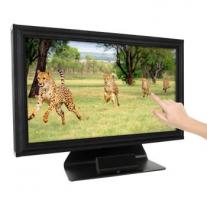Visual Stimulation / Bits# Stimulus Processor
Bits# Stimulus Processor

Bits# converts an ordinary computer or laptop into a wide dynamic range, calibrated visual stimulator and frame-synchronous data acquisition system. Bits# (Bits Sharp) is the successor to the ubiquitous CRS ViSaGe, VSG2/x and Bits++ systems and provides essential stimulus calibration and synchronisation features for vision research.
Bits# (Bits sharp) converts an ordinary computer or laptop into a wide dynamic range, calibrated visual stimulator and frame-synchronous data acquisition system. The new design replaces the Bits++ system and provides essential stimulus calibration and synchronisation features for vision research.
 Psykinematix for Mac OS X has joined Psychtoolbox-3 (MATLAB) and PsychoPy (Python) in providing native support for the Bits# (Bits sharp) stimulus processor. The open, non-proprietary nature of the Bits# video and USB interfaces means that our technology is easy for third-party developers to integrate with their software tools on any platform.
Psykinematix for Mac OS X has joined Psychtoolbox-3 (MATLAB) and PsychoPy (Python) in providing native support for the Bits# (Bits sharp) stimulus processor. The open, non-proprietary nature of the Bits# video and USB interfaces means that our technology is easy for third-party developers to integrate with their software tools on any platform.
- 14-bit analogue RGB video outputs for very high resolution luminance and colour displays on CRT monitors.
- Native 8-bit DVI output with support for 14-bit resolution using custom CRS dithering scheme. Ideal for use with LCD monitors, projectors and other digital input display devices with DVI or HDMI inputs.
- Concurrently supports three video modes: T-Lock frame synchronous 8/14 LUT animation mode, Mono++ 14-bit luminance mode and Color++ 42-bit colour pixel mode. All modes are available for analogue and DVI outputs.
- Transparent EDID stimulus monitor emulation and hardware gamma correction tables makes monitor setup and calibration easy. Compatible with CRS ColorCAL II colorimeter, SpectroCAL spectroradiometer and third-party light measurement systems.
- Ten TTL-compatible digital output lines for sending video frame/line synchronous triggers to control external equipment (e.g. indicate stimulus onset and include a stimulus specific marker pattern). Also included: Ten TTL-compatible digital input lines.
- Data acquisition interface: six 16bit, ±5V analogue inputs with 500Hz bandwidth and two more similar analogue outputs. All incoming data is sampled and time stamped relative to the stimulus video stream and transferred to the host computer by High-Speed USB using native USB CDC class drivers.
- RTBox compatible response box mode timestamps button states relative to the stimulus video stream and removes any uncertainty introduced by the host operating system. An essential feature for collecting reaction times. Compatible with CRS made CBx infrared response boxes or third-party hardware connected to the Bits# Digital I/O port.
- Integrated Stereo Goggle port for driving CRS FE-1 stereo goggles or third-party active stereo glasses (e.g. NVIDIA 3DVision, RealD CrystalEyes).
- Device generated Diagnostic Display and logging to internal SD card for easy debugging of stimulus configurations.
- Psychtoolbox-3 (MATLAB) and PsychoPy (Python) provide native support for the Bits# (Bits sharp) stimulus processor. The open, non-proprietary nature of the Bits# video and USB interfaces means that our technology is easy for third-party developers to integrate with their software tools on any platform.
- And much, much more! Ask us for more information including how to convert your current ViSaGe MKII system into Bits# with a free Firmware Upgrade.


